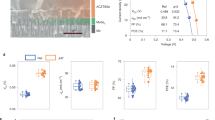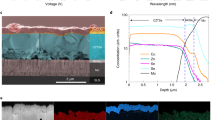Abstract
Sulfide kesterite Cu2ZnSnS4 provides an attractive low-cost, environmentally benign and stable photovoltaic material, yet the record power conversion efficiency for such solar cells has been stagnant at around 9% for years. Severe non-radiative recombination within the heterojunction region is a major cause limiting voltage output and overall performance. Here we report a certified 11% efficiency Cu2ZnSnS4 solar cell with a high 730 mV open-circuit voltage using heat treatment to reduce heterojunction recombination. This heat treatment facilitates elemental inter-diffusion, directly inducing Cd atoms to occupy Zn or Cu lattice sites, and promotes Na accumulation accompanied by local Cu deficiency within the heterojunction region. Consequently, new phases are formed near the hetero-interface and more favourable conduction band alignment is obtained, contributing to reduced non-radiative recombination. Using this approach, we also demonstrate a certified centimetre-scale (1.11 cm2) 10% efficiency Cu2ZnSnS4 photovoltaic device; the first kesterite cell (including selenium-containing) of standard centimetre-size to exceed 10%.
This is a preview of subscription content, access via your institution
Access options
Access Nature and 54 other Nature Portfolio journals
Get Nature+, our best-value online-access subscription
$29.99 / 30 days
cancel any time
Subscribe to this journal
Receive 12 digital issues and online access to articles
$119.00 per year
only $9.92 per issue
Buy this article
- Purchase on Springer Link
- Instant access to full article PDF
Prices may be subject to local taxes which are calculated during checkout





Similar content being viewed by others
References
Green, M. A. Commercial progress and challenges for photovoltaics. Nat. Energy 1, 15015 (2016).
Antunez, P. D., Bishop, D. M., Luo, Y. & Haight, R. Efficient kesterite solar cells with high open-circuit voltage for applications in powering distributed devices. Nat. Energy 2, 884–890 (2017).
Green, M. A. et al. Solar cell efficiency tables (version 51). Progress. Photovolt. Res. Appl. 26, 3–12 (2018).
Shin, D., Saparov, B. & Mitzi, D. B. Defect engineering in multinary earth-abundant chalcogenide photovoltaic materials. Adv. Energy Mater. 7, 1602366 (2017).
Shin, B. et al. Thin film solar cell with 8.4% power conversion efficiency using an earth-abundant Cu2ZnSnS4 absorber. Progress. Photovolt. Res. Appl. 21, 72–76 (2013).
Tajima, S., Umehara, M., Hasegawa, M., Mise, T. & Itoh, T. Cu2ZnSnS4 photovoltaic cell with improved efficiency fabricated by high-temperature annealing after CdS buffer-layer deposition. Progress. Photovolt. Res. Appl. 25, 14–22 (2017).
Polman, A., Knight, M., Garnett, E. C., Ehrler, B. & Sinke, W. C. Photovoltaic materials: present efficiencies and future challenges. Science 352, aad4424 (2016).
Hiroi, H., Iwata, Y., Adachi, S., Sugimoto, H. & Yamada, A. New world-record efficiency for pure-sulfide Cu(In,Ga)S2 thin-film solar cell with cd-free buffer layer via KCN-free process. IEEE J. Photovolt. 6, 760–763 (2016).
Gokmen, T., Gunawan, O., Todorov, T. K. & Mitzi, D. B. Band tailing and efficiency limitation in kesterite solar cells. Appl. Phys. Lett. 103, 103506 (2013).
Mitzi, D. B., Gunawan, O., Todorov, T. K., Wang, K. & Guha, S. The path towards a high-performance solution-processed kesterite solar cell. Sol. Energy Mater. Sol. Cells 95, 1421–1436 (2011).
Scragg, J. J. et al. Effects of back contact instability on Cu2ZnSnS4 devices and processes. Chem. Mater. 25, 3162–3171 (2013).
Siebentritt, S. Why are kesterite solar cells not 20% efficient? Thin Solid Films 535, 1–4 (2013).
Crovetto, A. & Hansen, O. What is the band alignment of Cu2ZnSn(S,Se)4 solar cells? Sol. Energy Mater. Sol. Cells 169, 177–194 (2017).
Liu, F. et al. Beyond 8% ultrathin kesterite Cu2ZnSnS4 solar cells by interface reaction route controlling and self-organized nanopattern at the back contact. NPG Asia Mater. 9, e401 (2017).
Vermang, B. et al. Rear surface optimization of CZTS solar cells by use of a passivation layer with nanosized point openings. IEEE J. Photovolt. 6, 332–336 (2016).
Redinger, A., Berg, D. M., Dale, P. J. & Siebentritt, S. The consequences of kesterite equilibria for efficient solar cells. J. Am. Chem. Soc. 133, 3320–3323 (2011).
Chen, S., Walsh, A., Gong, X.-G. & Wei, S.-H. Classification of lattice defects in the kesterite Cu2ZnSnS4 and Cu2ZnSnSe4 earth-abundant solar cell absorbers. Adv. Mater. 25, 1522–1539 (2013).
Larramona, G. et al. Fine-tuning the Sn content in CZTSSe thin films to achieve 10.8% solar cell efficiency from spray-deposited water–ethanol-based colloidal inks. Adv. Energy Mater. 5, 1501404 (2015).
Liu, F. et al. Nanoscale microstructure and chemistry of Cu2ZnSnS4/CdS interface in kesterite Cu2ZnSnS4 solar cells. Adv. Energy Mater. 6, 1600706 (2016).
Sun, K. et al. Over 9% efficient kesterite Cu2ZnSnS4 solar cell fabricated by using Zn1–xCdxS buffer layer. Adv. Energy Mater. 6, 1600046 (2016).
Yan, C. et al. Beyond 11% efficient sulfide kesterite Cu2ZnxCd1–xSnS4 solar cell: effects of cadmium alloying. ACS Energy Lett. 2, 930–936 (2017).
Ericson, T. et al. Zinc-tin-oxide buffer layer and low temperature post annealing resulting in a 9.0% efficient Cd-Free Cu2ZnSnS4 solar cell. Sol. RRL 1, 1700001 (2017).
Shin, T., Mitsutaro, U. & Takahiro, M. Photovoltaic properties of Cu2ZnSnS4 cells fabricated using ZnSnO and ZnSnO/CdS buffer layers. Jpn J. Appl. Phys. 55, 112302 (2016).
Platzer-Björkman, C. et al. Reduced interface recombination in Cu2ZnSnS4 solar cells with atomic layer deposition Zn1−xSnxOy buffer layers. Appl. Phys. Lett. 107, 243904 (2015).
Shin, T., Tadayoshi, I., Hirofumi, H., Keiichiro, O. & Ryoji, A. Improvement of the open-circuit voltage of Cu2ZnSnS4 solar cells using a two-layer structure. Appl. Phys. Express 8, 082302 (2015).
Gunawan, O., Gokmen, T., Shin, B. S. & Guha, S. Device characteristics of high performance Cu2ZnSnS4 solar cell. In 38th IEEE Photovoltaic Specialists Conf. 003001–003003 (2012).
Jackson, P. et al. Effects of heavy alkali elements in Cu(In,Ga)Se2 solar cells with efficiencies up to 22.6%. Phys. Status Solidi RRL 10, 583–586 (2016).
Kannan, R., Keane, J. & Noufi, R. Properties of high-efficiency CIGS thin-film solar cells. In 31st IEEE Photovoltaic Specialists Conf. 195–198 (2005).
Green, M. A. et al. Solar cell efficiency tables (version 49). Progress. Photovolt. Res. Appl. 25, 3–13 (2017).
Tajima, S. et al. Atom-probe tomographic study of interfaces of Cu2ZnSnS4 photovoltaic cells. Appl. Phys. Lett. 105, 093901 (2014).
Sousa, M. G. et al. Optimization of post-deposition annealing in Cu2ZnSnS4 thin film solar cells and its impact on device performance. Sol. Energy Mater. Sol. Cells 170, 287–294 (2017).
Wen, X. et al. Ultrafast electron transfer in the nanocomposite of the graphene oxide-Au nanocluster with graphene oxide as a donor. J. Mater. Chem. C 2, 3826–3834 (2014).
Kunz, O., Varlamov, S. & Aberle, A. G. Modelling the effects of distributed series resistance on Suns-VOC, m-VOC and JSC-Suns curves of solar cells. In 34th IEEE Photovoltaic Specialists Conf. 000158–000163 (2009).
Sah, Ct, Noyce, R. N. & Shockley, W. Carrier generation and recombination in P-N junctions and P-N junction characteristics. Proc. IRE 45, 1228–1243 (1957).
Todorov, T. K. et al. Beyond 11% efficiency: characteristics of state-of-the-art Cu2ZnSn(S,Se)4 solar cells. Adv. Energy Mater. 3, 34–38 (2013).
Bhattacharya, R. N. et al. High efficiency thin-film CuIn1−xGaxSe2 photovoltaic cells using a Cd1−xZnxS buffer layer. Appl. Phys. Lett. 89, 253503 (2006).
Tosun, B. S., Pettit, C., Campbell, S. A. & Aydil, E. S. Structure and composition of ZnxCd1–xS films synthesized through chemical bath deposition. Acs Appl. Mater. Inter. 4, 3676–3684(2012).
Nellist, P. D. & Pennycook, S. J. Incoherent imaging using dynamically scattered coherent electrons. Ultramicroscopy 78, 111–124 (1999).
Rafferty, B., Nellist, D. & Pennycook, J. On the origin of transverse incoherence in Z-contrast STEM. J. Electron Microsc. 50, 227–233 (2001).
Yuan, Z.-K. et al. Engineering solar cell absorbers by exploring the band alignment and defect disparity: the case of Cu- and Ag-based kesterite compounds. Adv. Funct. Mater. 25, 6733–6743 (2015).
Su, Z. et al. Cation substitution of solution-processed Cu2ZnSnS4 thin film solar cell with over 9% efficiency. Adv. Energy Mater. 5, 1500682 (2015).
Hironiwa, D. et al. Impact of annealing treatment before buffer layer deposition on Cu2ZnSn(S,Se)4 solar cells. Thin Solid Films 582, 151–153 (2015).
Xie, H. et al. Impact of Na dynamics at the Cu2ZnSn(S,Se)4/CdS interface during post low temperature treatment of absorbers. Acs Appl. Mater. Inter. 8, 5017–5024 (2016).
Li, J. V., Kuciauskas, D., Young, M. R. & Repins, I. L. Effects of sodium incorporation in Co-evaporated Cu2ZnSnSe4 thin-film solar cells. Appl. Phys. Lett. 102, 163905 (2013).
Liu, C.-Y. et al. Sodium passivation of the grain boundaries in CuInSe2 and Cu2ZnSnS4 for high-efficiency solar cells. Adv. Energy Mater. 7, 1601457 (2017).
Chirilă, A. et al. Potassium-induced surface modification of Cu(In,Ga)Se2 thin films for high-efficiency solar cells. Nat. Mater. 12, 1107–1111 (2013).
Santoni, A. et al. Valence band offset at the CdS/Cu2ZnSnS4 interface probed by x-ray photoelectron spectroscopy. J. Phys. D 46, 175101 (2013).
Minemoto, T. et al. Theoretical analysis of the effect of conduction band offset of window/CIS layers on performance of CIS solar cells using device simulation. Sol. Energy Mater. Sol. Cells 67, 83–88 (2001).
Acknowledgements
This contribution has been financially supported by the Australian Government through the Australian Renewable Energy Agency (ARENA) (grant no. 1-USO028 and 1-SRI001) and the Australian Research Council (ARC) and Baosteel (grant no. LP150100911). The authors thank C. Kong and K. Levick for technical assistance and use of facilities at the Electron Microscope Unit at University of New South Wales. The authors acknowledge the facilities, and the scientific and technical assistance, of the Australian Microscopy and Microanalysis Research Facility at the Australian Centre for Microscopy and Microanalysis at the University of Sydney. The authors appreciate the use of facilities and the assistance of D. Mitchell and G. Casillas Garcia at the University of Wollongong Electron Microscopy Centre. We thank R. Liu at the Western Sydney University SIMS Facility. C.Y. would like to acknowledge the insightful discussions with Z. Su, H. Sugimoto, H. Hiroi and A. Crovetto.
Author information
Authors and Affiliations
Contributions
M.A.G. and X.H. supervised the whole project. C.Y., F.L. and X.H conceived the idea and designed the experiments. C.Y. and Y.Z. fabricated the solar cell devices. J.H. prepared TEM specimens and performed HAADF characterizations. K.S. assisted TRPL characterizations. S.J. conducted temperature-dependent measurements. L.Y. and K.E. prepared APT samples and conducted APT measurements, respectively. C.Y., J.H., K.S., A.P., S.J., K.E., J.M.C., N.J.E.-D., S.C., Z.H. and H.S. analysed the data. Z.H., F.L. and M.H. helped with characterizations, J.A.S., F.L., H.S. and M.H. assisted the experiments. C.Y., J.H., X.H. and M.A.G. wrote the paper. All authors commented on the manuscript.
Corresponding authors
Ethics declarations
Competing interests
The authors declare no competing interests.
Additional information
Publisher’s note: Springer Nature remains neutral with regard to jurisdictional claims in published maps and institutional affiliations.
Supplementary information
Supplementary Information
Supplementary Figures 1–19, Supplementary Tables 1–9, Supplementary Notes 1–4, Supplementary References
Rights and permissions
About this article
Cite this article
Yan, C., Huang, J., Sun, K. et al. Cu2ZnSnS4 solar cells with over 10% power conversion efficiency enabled by heterojunction heat treatment. Nat Energy 3, 764–772 (2018). https://doi.org/10.1038/s41560-018-0206-0
Received:
Accepted:
Published:
Issue Date:
DOI: https://doi.org/10.1038/s41560-018-0206-0
This article is cited by
-
Optical and structural characterization of chemically deposited CuCrSnS4 thin films
Journal of Materials Science: Materials in Electronics (2024)
-
Single-phase evolution path to new record efficiency of kesterite solar cells
Science China Chemistry (2024)
-
Cauliflower Cu2ZnSnS4:Na film prepared by single-pot hydrothermal approach for photovoltaic application: impact of NaOH additive
Journal of Applied Electrochemistry (2024)
-
Potential window alignment regulating ion transfer in faradaic junctions for efficient photoelectrocatalysis
Nature Communications (2023)
-
Control of the phase evolution of kesterite by tuning of the selenium partial pressure for solar cells with 13.8% certified efficiency
Nature Energy (2023)



